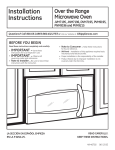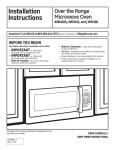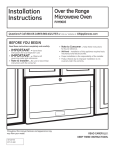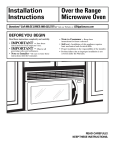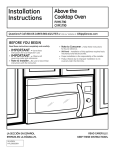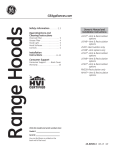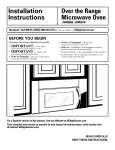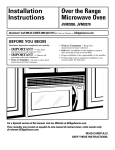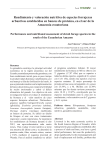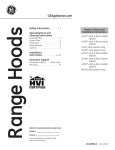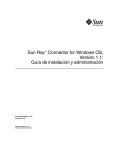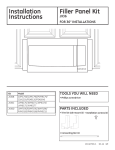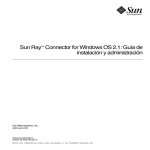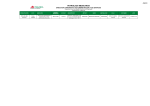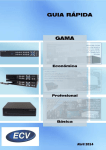Download GE CVM1750SHSS Instructions / Assembly
Transcript
Installation Instructions Above the Cooktop Oven PVM1790 CVM1790 CVM1750 Questions? Call 800.GE.CARES (800.432.2737) or Visit our Website at: GEAppliances.com BEFORE YOU BEGIN Read these instructions completely and carefully. • IMPORTANT – Save these instructions for local inspector’s use. • IMPORTANT – Observe all • Note to Installer – Be sure to leave these governing codes and ordinances. instructions with the Consumer. LA SECCIÓN EN ESPAÑOL EMPIEZA EN LA PÁGINA 25. 49-40724 06-14 GE MFL06244904 Note to Consumer – Keep these instructions for future reference. • Skill level – Installation of this appliance requires basic mechanical and electrical skills. • Proper installation is the responsibility of the installer. • Product failure due to improper installation is not covered under the Warranty. • READ CAREFULLY. KEEP THESE INSTRUCTIONS. Installation Instructions C Recirculating ................................................. 19–22 CONTENTS Attach Mounting Plate to Wall ................ 19 General information Preparation of Top Cabinet...................... 19 Important Safety Instructions........................................ 3 Electrical Requirements .................................................. 3 Adapting Blower for Recirculation ..................................20, 21 Hood Exhaust ................................................................ 4, 5 Mount the Oven...................................21, 22 Damage – Shipment/Installation .................................. 6 Installing the Charcoal Filter .................... 22 Parts Included ................................................................... 6 Before You Use Your Oven .......................................... 23 Tools You Will Need ......................................................... 7 Sección en Español ................................................. 25–47 Mounting Space ................................................................ 7 Step-by-step installation guide Placement of Mounting Plate .................................. 8–10 Removing the Mounting Plate ............................. 8 Finding the Wall Studs.......................................... 8 Determining Wall Plate Location ........................ 9 Aligning the Wall Plate ....................................... 10 Installation Types .................................................... 11–22 A Outside Top Exhaust .................................... 12–14 Attach Mounting Plate to Wall .................12 Preparation of Top Cabinet.......................13 Assemble and Install Adaptor ..................13 Mount the Oven................................... 13, 14 Adjust the Exhaust Adaptor ......................14 Connecting Ductwork ................................14 B Outside Back Exhaust.................................. 15–18 Preparing Rear Wall for Outside Back Exhaust ................................15 Attach Mounting Plate to Wall .......... 15, 16 Preparation of Top Cabinet.......................16 Adapting Blower for Outside Back Exhaust .......................................... 16, 17 Mount the Oven..........................................18 2 Installation Instructions IMPORTANT SAFETY INSTRUCTIONS A qualified electrician must perform a ground continuity check on the wall receptacle before beginning the installation to ensure that the outlet box is properly grounded. If not properly grounded, or if the wall receptacle does not meet electrical requirements noted (under ELECTRICAL REQUIREMENTS), a qualified electrician should be employed to correct any deficiencies. Where a standard two-prong wall receptacle is encountered, it must be replaced with a properly grounded three-prong wall receptacle, installed by a qualified electrician. WARNING: Risk of Electric Shock. Can cause injury or death: DO NOT, under any circumstances, cut, deform or remove any of the prongs from the power cord. Do not use with an extension cord. Failure to comply may cause fire. WARNING: Risk of Electric Shock. Can cause injury or death: Remove house fuse or open circuit breaker before beginning installation to avoid severe or fatal shock injury. CAUTION: For personal safety, the mounting surface must be capable of supporting the cabinet load, in addition to the added weight of this 63–85 pound product, plus additional oven loads of up to 50 pounds or a total weight of 113–135 pounds. CAUTION: For personal safety, this product cannot be installed in cabinet arrangements such as an island or a peninsula. It must be mounted to BOTH a top cabinet AND a wall. WARNING: Risk of Electric Shock. Can cause injury or death: THIS APPLIANCE MUST BE PROPERLY GROUNDED to avoid severe or fatal shock. CAUTION: To avoid the risk of personal injury (back injury or other injuries due to excessive weight of the microwave oven) or property damage, you will need two people to install this microwave oven. 120 V Models Ensure proper ground exists before use The power cord of this appliance is equipped with a three-prong (grounding) plug which mates with a standard three-prong (grounding) wall receptacle to minimize the possibility of electric shock hazard from this appliance. ELECTRICAL REQUIREMENTS 120 V Models This product requires a three-prong grounded outlet. Product rating is 120 volts AC, 60 Hertz, 15 amps, and 1.70 kilowatts. This product must be connected to a supply circuit of the proper voltage and frequency. Wire size must conform to the requirements of the National Electrical Code or the prevailing local code for this kilowatt rating. The power supply cord and plug should be brought to a separate 15 to 20 ampere branch circuit single grounded outlet. The outlet box should be located in the cabinet above the oven and away from any potential microwave oven ducting.The outlet box and supply circuit should be installed by a qualified electrician and conform to the National Electrical Code or the prevailing local code. 3 Installation Instructions HOOD EXHAUST NOTE: Read these next two pages only if you plan to vent your exhaust to the outside. If you plan to recirculate the air back into the room, proceed to page 6. OUTSIDE TOP EXHAUST (EXAMPLE ONLY) The following chart describes an example of one possible ductwork installation. EQUIVALENT LENGTH x NUMBER USED = EQUIVALENT LENGTH Roof Cap 24 Ft. x (1) = 24 Ft. 12 Ft. Straight Duct (6s Round) 12 Ft. x (1) = 12 Ft. Rectangular-to-Round Transition Adaptor* 5 Ft. x (1) = 5 Ft. = 41 Ft. DUCT PIECES Equivalent lengths of duct pieces are based on actual tests and reflect requirements for good venting performance with any vent hood. Total Length *IMPORTANT: If a rectangular-to-round transition adaptor is used, the bottom corners of the damper will have to be cut to fit, using the tin snips, in order to allow free movement of the damper. OUTSIDE BACK EXHAUST (EXAMPLE ONLY) The following chart describes an example of one possible ductwork installation. EQUIVALENT LENGTH* x NUMBER USED = EQUIVALENT LENGTH 40 Ft. x (1) = 40 Ft. 3 Ft. Straight Duct 3 Ft. (31ø4s x 10s Rectangular) x (1) = 3 Ft. 90° Elbow x (2) = 20 Ft. = 63 Ft. DUCT PIECES Wall Cap 10 Ft. Equivalent lengths of duct pieces are based on actual tests and reflect requirements for good venting performance with any vent hood. Total Length NOTE: For back exhaust, care should be taken to align exhaust with space between studs, or wall should be prepared at the time it is constructed by leaving enough space between the wall studs to accommodate exhaust. 4 Installation Instructions Maximum duct length: NOTE: If you need to install ducts, note that the total duct length of 31ø4s x 10s rectangular or 6s diameter round duct should not exceed 140 equivalent feet. Outside ventilation requires a HOOD EXHAUST DUCT. Read the following carefully. NOTE: It is important that venting be installed using the most direct route and with as few elbows as possible. This ensures clear venting of exhaust and helps prevent blockages. Also, make sure dampers swing freely and nothing is blocking the ducts. For satisfactory air movement, the total duct length of 31ø4s x 10s rectangular or 6s diameter round duct should not exceed 140 equivalent feet. Elbows, transitions, wall and roof caps, etc., present additional resistance to airflow and are equivalent to a section of straight duct which is longer than their actual physical size. When calculating the total duct length, add the equivalent lengths of all transitions and adaptors plus the length of all straight duct sections. The chart below shows you how to calculate total equivalent ductwork length using the approximate feet of equivalent length of some typical ducts. Exhaust connection: The hood exhaust has been designed to mate with a standard 31ø4s x 10s rectangular duct. If a round duct is required, a rectangular-to-round transition adaptor must be used. Do not use less than a 6s diameter duct. EQUIVALENT LENGTH x NUMBER USED = Rectangular-to-Round Transition Adaptor* 5 Ft. x ( ) = Ft. Wall Cap 40 Ft. x ( ) = Ft. 90° Elbow 10 Ft. x ( ) = Ft. 45° Elbow 5 Ft. x ( ) = Ft. 90° Elbow 25 Ft. x ( ) = Ft. 45° Elbow 5 Ft. x ( ) = Ft. Roof Cap 24 Ft. x ( ) = Ft. Straight Duct 6s Round or 31ø4s x 10s Rectangular 1 Ft. x ( ) = Ft. Total Ductwork = Ft. DUCT PIECES * IMPORTANT: If a rectangular-to-round transition adaptor is used, the bottom corners of the damper will have to be cut to fit, using the tin snips, in order to allow free movement of the damper. EQUIVALENT LENGTH Equivalent lengths of duct pieces are based on actual tests and reflect requirements for good venting performance with any vent hood. 5 Installation Instructions PARTS INCLUDED DAMAGE – SHIPMENT/ INSTALLATION ADDITIONAL PARTS • If the unit is damaged in shipment, return the unit to the store in which it was bought for repair or replacement. • If the unit is damaged by the customer, repair or replacement is the responsibility of the customer. • If the unit is damaged by the installer (if other than the customer), repair or replacement must be made by arrangement between customer and installer. PART ≤ ≤ ≤ PARTS INCLUDED HARDWARE PACKET PART QUANTITY Top Cabinet Template 1 Rear Wall Template 1 Installation Instructions 1 Separately 2 QUANTITY Wood Screws (1ø4s x 2s) 2 Toggle Bolts (and wing nuts) (1ø4s x 3s) 4 Self-aligning Machine Screw (1ø4s-28 x 25ø8s) 3 Nylon Grommet (for metal cabinets) 2 Metal Screws (1ø8s x 1ø2s) Packed Grease Filters Exhaust Adaptor 1 Damper 1 1 black 2 bronze You will find the installation hardware contained in a packet with the unit. Check to make sure you have all these parts. NOTE: Some extra parts are included. 6 Installation Instructions TOOLS YOU WILL NEED # 1 and #2 Phillips screwdriver Tin snips (for cutting damper, if required) Ruler or tape measure and straight edge Pencil Scissors (to cut template, if necessary) Electric drill with 3ø16s, 7ø16s, 1ø2s and 5ø8s drill bits Gloves Saw (saber, hole or keyhole) Level MOUNTING SPACE 13smax. 30s 2s 30s min. Filler blocks or scrap wood pieces, if needed for top cabinet spacing (used on recessed bottom cabinet installations only) Stud finder or Hammer (optional) Safety goggles 16-1ø4s Carpenter square (optional) Bottom edge of cabinet needs to be 30s or more from the cooking surface Backsplash 66s or more from the floor to the top of the oven 7 Duct and masking tape NOTES: • The space between the cabinets must be 30s wide and free of obstructions. • If the space between the cabinets is greater than 30s, a Filler Panel Kit may be used to fill in the gap between the oven and the cabinets. Your Owner’s Manual contains the kit number for your model. • This oven is for installation over ranges up to 36s wide. • If you are going to vent your oven to the outside, see Hood Exhaust Section for exhaust duct preparation. • When installing the oven beneath smooth, flat cabinets, be careful to follow the instructions on the top cabinet template for power cord clearance. • Maximum cabinet depth above and beside the unit is 13s. • For models with top venting holes: Do not allow cabinetry or other objects to block the airflow of the vent. • The product should not be installed over any cooktop or range with a combined BTU greater than 60000 BTU. Installation Instructions 1 PLACEMENT OF THE MOUNTING PLATE A REMOVING THE OVEN FROM THE CARTON/REMOVING THE MOUNTING PLATE B FINDING THE WALL STUDS 1 Remove the box containing the installation instructions, filters, exhaust adaptor, damper and the small hardware bag. Do not remove the Styrofoam protecting the front of the oven. Wall Studs 2 Fold back all 4 carton flaps fully against carton sides. Then carefully roll the oven and carton over onto the top side. The oven should be resting in the Styrofoam. Center 1 Find the studs, using one of the following methods: A. Stud finder – a magnetic device which locates nails. OR B. Use a hammer to tap lightly across the mounting surface to find a solid sound. This will indicate a stud location. 2 After locating the stud(s), find the center by probing the wall with a small nail to find the edges of the stud. Then place a mark halfway between the edges. The center of any adjacent studs should be 16s or 24s from this mark. 3 Draw a line down the center of the studs. IMPORTANT: The microwave oven must be connected to at least one wall stud. Carton Styrofoam 3 Pull the carton up and off the oven. 4 The mounting plate is attached to the back of the oven. Remove the two screws holding it to the oven. The plate will be used as the rear wall template and for mounting the oven to the wall. 5 Set the oven upright. Remove and properly discard plastic bags and Styrofoam. 6 Open the oven door and remove the styrofoam pack from inside the oven. Remove the tape covering the turntable hub. 8 Installation Instructions C DETERMINING WALL PLATE LOCATION UNDER YOUR CABINET Plate position – beneath framed recessed cabinet bottom Plate position – beneath flat bottom cabinet Mounting Plate Tabs Touching the Back Frame Mounting Plate Tabs Touching the Cabinet Bottom 30s to Cooktop At least 30s, up to 36s Plate position – beneath recessed bottom cabinet with front overhang Your cabinets may have decorative trim that interferes with the oven installation. Remove the decorative trim to install the oven properly and to make it level. THE OVEN MUST BE LEVEL. Use a level to make sure the cabinet bottom is level. Mounting Plate with Tabs Below Cabinet Bottom the Same Distance as the Front Overhang Depth If the cabinets have a front overhang only, with no back or side frame, install the mounting plate down the same distance as the front overhang depth. This will keep the oven level. 1 Measure the inside depth of the front overhang. 2 Draw a horizontal line on the back wall an equal distance below the cabinet bottom as the inside depth of the front overhang. 3 For this type of installation with front overhang only, align the mounting tabs with this horizontal line, not touching the cabinet bottom as described in Step D. 30s to Cooktop 9 Installation Instructions D ALIGNING THE WALL PLATE Hole B Draw a Vertical Line on Wall from Center of Top Cabinet Hole A Hole D Hole C Area E CAUTION: Wear gloves to avoid cutting fingers on sharp edges. 1 Draw a vertical line on the wall at the center of the 30s wide space. 2 Use the mounting plate as the template for the rear wall. Place the mounting plate on the wall, making sure that the tabs are touching the bottom of the cabinet or the level line drawn in Step C for cabinets with front overhang. Line up the notch and center line on the mounting plate to the center line on the wall. 3 While holding the mounting plate with one hand, draw circles on the wall at holes A, B, C and D (see illustration above/actual plate marked with arrows). Four holes must be used for mounting. NOTE: Holes C and D are inside area E. If neither C nor D is in a stud, find a stud somewhere in area E and draw a fifth circle to line up with the stud. It is important to use at least one wood screw mounted firmly in a stud to support the weight of the oven. Set the mounting plate aside. WARNING: Risk of electric shock. Can cause injury or death. Take care to not drill into electrical wiring inside walls or cabinets. 4 Drill holes on the circles. If there is a stud, drill a 3ø16s hole for wood screws. For holes that don’t line up with a stud, drill a 5ø8s hole for toggle bolts. NOTE: DO NOT MOUNT THE PLATE AT THIS TIME. 10 Installation Instructions 2 INSTALLATION TYPES (Choose A, B or C) This oven is designed for adaptation to the following 3 types of ventilation: A. Outside Top Exhaust (Vertical Duct) B. Outside Back Exhaust (Horizontal Duct) C. Recirculating (Non-Vented Ductless) A NOTE: This oven is shipped assembled for Outside Top Exhaust. Select the type of ventilation required for your installation and proceed to that section. OUTSIDE TOP EXHAUST (VERTICAL DUCT) B OUTSIDE BACK EXHAUST (HORIZONTAL DUCT) Adaptor in Place for Outside Top Exhaust See page 12 See page 15 C RECIRCULATING (NON-VENTED DUCTLESS) A Charcoal Filter Accessory Kit is required for the non-vented exhaust. (See your Owner’s Manual for the kit number.) See page 19 11 Installation Instructions A OUTSIDE TOP EXHAUST (Vertical Duct) INSTALLATION OVERVIEW A1. Attach Mounting Plate to Wall A2. Prepare Top Cabinet A3. Install Adaptor A4. Mount Oven A5. Adjust Exhaust Adaptor A6. Connect Ductwork To use toggle bolts: A1 ATTACH THE MOUNTING PLATE TO THE WALL B A Mounting Plate Spacing for Toggles More Than Wall Thickness Toggle Wings Toggle Bolt Wall C Bolt End 3 Place the mounting plate against the wall and insert the toggle wings into the holes in the wall to mount the plate. NOTE: Before tightening toggle bolts and wood screw, make sure the tabs on the mounting plate touch the bottom of the cabinet when pushed flush against the wall and that the plate is properly centered under the cabinet. D Attach the plate to the wall using toggle bolts. At least one wood screw must be used to attach the plate to a wall stud. Recommended locations on the mounting plate are indicated by A, B, C and D. 1 Remove the toggle wings from the bolts. 2 Insert the bolts into the mounting plate through the holes designated to go into drywall and reattach the toggle wings to 3ø4s onto each bolt. CAUTION: Be careful to avoid pinching fingers between the back of the mounting plate and the wall. 4 Tighten all bolts. Pull the plate away from the wall to help tighten the bolts. 12 Installation Instructions A2 USE TOP CABINET TEMPLATE FOR PREPARATION OF TOP CABINET A4 MOUNT THE OVEN You need to drill holes for the top support screws, a hole large enough for the power cord to fit through, and a cutout large enough for the exhaust adaptor. CAUTION: To avoid the risk of personal injury (back injury or other injuries due to excessive weight of the microwave oven) or property damage, you will need two people to install this microwave oven. IMPORTANT: Do not grip or use handle during installation. WARNING: Risk of Electric Shock. Can cause injury or death: If installing unit with metal countertops, cover the edge of the power supply cord hole with the power supply cord bushing. • Read the instructions on the TOP CABINET TEMPLATE. • Tape it underneath the top cabinet. • Drill the holes, following the instructions on the TOP CABINET TEMPLATE. IMPORTANT: If filler blocks are not used, case damage may occur from overtightening screws. CAUTION: Wear safety goggles when drilling holes in the cabinet bottom. NOTE: When mounting the microwave oven, thread power cord through hole in bottom of top cabinet. Keep it tight throughout Steps 1–3. Do not pinch cord or lift oven by pulling cord. A3 ASSEMBLE AND INSTALL ADAPTOR Damper 1 Lift microwave oven, tilt it forward, and hook slots at back bottom edge onto four lower tabs of mounting plate. Exhaust Adaptor Blower Plate Back of Oven 1 Place the oven in its upright position, with the top of the unit facing up. 2 Insert the tabs on each side of the damper into the holes at the inside rear of the adaptor. 3 Attach the exhaust adaptor to the blower plate with the two bronze metal screws provided. Make sure that the damper pivots easily before mounting oven. You will need to make adjustments to assure proper alignment with your house exhaust duct after the oven is installed. 2 Rotate front of oven up against cabinet bottom. 3 Insert a self-aligning screw through top-center cabinet hole. Temporarily secure the oven by turning the screw at least two full turns after the threads have engaged. (It will be completely tightened later.) 13 Installation Instructions A5 ADJUST THE EXHAUST ADAPTOR A4 MOUNT THE OVEN (continued) Open the top cabinet and adjust the exhaust adaptor to connect to the house duct. 3 Attach the oven to the top cabinet. 4 Insert 3 self-aligning screws (1ø4s-28 x ȓs) through outer top cabinet holes. Turn two full turns on each screw. Damper Back of Oven A6 CONNECTING DUCTWORK House Duct Cabinet Front Cabinet Bottom Shelf Filler Block Equivalent to depth of cabinet recess This distance can NOT exceed 2” to ensure proper installation Self-Aligning Screw Oven Top 1 Extend the house duct down to connect to the exhaust adaptor. 2 Seal exhaust duct joints using duct tape. 5 Tighten the outer two screws to the top of the oven. (While tightening screws, hold the oven in place against the wall and the top cabinet.) 6 Install grease filters. See the Owner’s Manual packed with the oven. 14 Installation Instructions B OUTSIDE BACK EXHAUST (Horizontal Duct) INSTALLATION OVERVIEW B1. Prepare Rear Wall B2. Attach Mounting Plate to Wall B3. Prepare Top Cabinet B4. Adjust Blower B5. Mount the Oven B2 ATTACH THE MOUNTING PLATE TO THE WALL B1 PREPARING THE REAR WALL FOR OUTSIDE BACK EXHAUST You need to cut an opening in the rear wall for outside exhaust. Attach the plate to the wall using toggle bolts. At least one wood screw must be used to attach the plate to a wall stud. 1 Remove the toggle wings from the bolts. 2 Insert the bolts into the mounting plate through the holes designated to go into drywall and reattach the toggle wings to 3ø4s onto each bolt. • Read the instructions on the REAR WALL TEMPLATE. • Tape it to the rear wall, lining up with the holes previously drilled for holes A and B in the wall plate. • Cut the opening, following the instructions of the REAR WALL TEMPLATE. 15 Installation Instructions To use toggle bolts: Mounting Plate B4 ADAPTING BLOWER FOR OUTSIDE BACK EXHAUST Spacing for Toggles More Than Wall Thickness Toggle Wings Toggle Bolt Wall 1 Remove the three screws that hold the blower plate to the oven. Slide blower plate from under its retaining flange. Remove and save the screw that holds blower motor to oven. Retaining Flange Bolt End 3 Place the mounting plate against the wall and insert the toggle wings into the holes in the wall to mount the plate. NOTE: Before tightening toggle bolts and wood screw, make sure the tabs on the mounting plate touch the bottom of the cabinet when pushed flush against the wall and that the plate is properly centered under the cabinet. Blower Plate Blower Motor Screw 2 Carefully pull out the blower unit. The wires will extend far enough to allow you to adjust the blower unit. BEFORE: Fan Blade Openings Facing Up CAUTION: Be careful to avoid pinching fingers between the back of the mounting plate and the wall. 4 Tighten all bolts. Pull the plate away from the wall to help tighten the bolts. End B End A 3 Rotate blower unit counterclockwise 180°. B3 USE TOP CABINET TEMPLATE FOR PREPARATION OF TOP CABINET Before Rotation After Rotation You need to drill holes for the top support screws and a hole large enough for the power cord to fit through. Back of Oven Back of Oven 4 Gently remove the wires from the grooves. Reroute the wires through grooves on other side of the blower unit. Before Rerouting • Read the instructions on the TOP CABINET TEMPLATE. • Tape it underneath the top cabinet. • Drill the holes, following the instructions on the TOP CABINET TEMPLATE. Wires Routed Through Right Side CAUTION: Wear safety goggles when drilling holes in the cabinet bottom. 16 After Rerouting Wires Routed Through Left Side Installation Instructions 5 Roll the blower unit 90° so that fan blade openings are facing out the back of the oven. 8 Replace the blower plate in the same position as before with the screws. Blower Plate Screws Blower Plate After Rolling Before Rolling Back of Oven Back of Oven 9 Insert the tabs on each side of the damper into the holes at the inside rear of the adaptor. Back of Oven 6 Locate the two “knockout” plates, on the rear oven panel, near the top of the oven. Using tin snips, carefully cut the web area from the two holes side-by-side (that secure the knockouts to the oven). Cut all four webs on both rear knockouts; this will allow the ventilation fan airflow to exhaust out the rear of the oven. Exhaust Adaptor CAUTION: Be sure to trim the sharp edges from the openings after removing the knockout plates. 10 Attach the exhaust adaptor to the rear of the oven by sliding it into the guides at the top center of the back of the oven. Oven Rear Panel Snip all 4 webs on each knockout panel and remove the metal knockouts for rear airflow. Exhaust Adaptor Slide exhaust adaptor into guides on oven rear. 7 Place the blower unit back into the opening. AFTER: Fan Blade Openings Facing Back Damper (hinge side up) Screws Locking Tabs End A Back of Oven Guides Push in securely until it is in the lower locking tabs. Take care to assure the damper hinge is installed so that it is at the top and that the damper swings freely. End B 11 Secure the exhaust adaptor to the oven with the two bronze metal screws provided. WARNING: Risk of electric shock can cause injury or death. Do not pull or stretch the blower unit wiring. make sure the wires are not pinched.. NOTE: The blower unit exhaust openings should match exhaust openings on rear of microwave oven. 17 Installation Instructions Cabinet Front Cabinet Bottom Shelf B5 MOUNT THE OVEN Filler Block Equivalent to depth of cabinet recess CAUTION: This distance can NOT exceed 2” to ensure proper installation Self-Aligning Screw To avoid the risk of personal injury (back injury or other injuries due to excessive weight of the microwave oven) or property damage, you will need two people to install this microwave oven. Oven Top 4 Attach the oven to the top cabinet. 5 Insert 3 self-aligning screws (1ø4s[ȓs) through outer top cabinet holes. Turn two full turns on each screw. IMPORTANT: Do not grip or use handle during installation. WARNING: Risk of Electric Shock. Can cause injury or death: If installing unit with metal countertops, cover the edge of the power supply cord hole with the power supply cord bushing. IMPORTANT: If filler blocks are not used, case damage may occur from overtightening screws. NOTE: When mounting the microwave oven, thread power cord through hole in bottom of top cabinet. Keep it tight throughout Steps 1–3. Do not pinch cord or lift oven by pulling cord. 1 Lift microwave oven, tilt it forward, and hook slots at back bottom edge onto four lower tabs of mounting plate. 6 Tighten the outer two screws to the top of the oven. (While tightening screws, hold the oven in place against the wall and the top cabinet.) 7 Install grease filters. See the Owner’s Manual packed with the oven. 2 Rotate front of oven up against cabinet bottom. 3 Insert a self-aligning screw through top-center cabinet hole. Temporarily secure the oven by turning the screw at least two full turns after the threads have engaged. (It will be completely tightened later.) 18 Installation Instructions C RECIRCULATING (Non-Vented Ductless) INSTALLATION OVERVIEW C1. Attach Mounting Plate to Wall C2. Prepare Top Cabinet C3. Adjust Blower C4. Mount the Oven C5. Install Charcoal Filter (not supplied) 3 Place the mounting plate against the wall and insert the toggle wings into the holes in the wall to mount the plate. NOTE: Before tightening toggle bolts and wood screw, make sure the tabs on the mounting plate touch the bottom of the cabinet when pushed flush against the wall and that the plate is properly centered under the cabinet. C1 ATTACH THE MOUNTING PLATE TO THE WALL CAUTION: Be careful to avoid pinching fingers between the back of the mounting plate and the wall. 4 Tighten all bolts. Pull the plate away from the wall to help tighten the bolts. Attach the plate to the wall using toggle bolts. At least one wood screw must be used to attach the plate to a wall stud. 1 Remove the toggle wings from the bolts. 2 Insert the bolts into the mounting plate through the holes designated to go into drywall and reattach the toggle wings to 3ø4s onto each bolt. C2 USE TOP CABINET TEMPLATE FOR PREPARATION OF TOP CABINET You need to drill holes for the top support screws and a hole large enough for the power cord to fit through. To use toggle bolts: Mounting Plate Spacing for Toggles More Than Wall Thickness Toggle Wings Toggle Bolt Wall • Read the instructions on the TOP CABINET TEMPLATE. • Tape it underneath the top cabinet. • Drill the holes, following the instructions on the TOP CABINET TEMPLATE. Bolt End CAUTION: Wear safety goggles when drilling holes in the cabinet bottom. 19 Installation Instructions C3 ADAPTING BLOWER FOR RECIRCULATION 3 Carefully pull out the blower unit. The wires will extend far enough to allow you to adjust the blower unit. NOTE: The exhaust adaptor with damper is not needed for recirculating models. You may want to save them for possible future use. 1 Remove and save screws that hold blower plate to the oven. Blower Plate Screws 4 Roll the blower unit 90° so that fan blade openings are facing toward the front of the oven. BEFORE: Fan Blade Openings Facing Up Back of Oven 2 Slide the blower plate from under its retaining flange and lift it off. Remove and save screw that holds the blower motor to oven. Retaining Flange Roll Blower Plate Blower Motor Screw AFTER: Fan Blade Openings Facing Forward NOTE: Make sure wires remain routed in the grooves of the motor frame. 20 Installation Instructions C4 MOUNT THE OVEN C3 ADAPTING BLOWER FOR RECIRCULATION (continued) 5 Place the blower unit back into the opening. WARNING: Risk of electric shock can cause injury or death. Do not pull or stretch the blower unit wiring. Make sure the wired are not pinched. CAUTION: To avoid the risk of personal injury (back injury or other injuries due to excessive weight of the microwave oven) or property damage, you will need two people to install this microwave oven. 6 Secure blower unit to oven with the 2 screws removed in Step 2. Insert the screw in bottom right screw hole on the back of the oven. IMPORTANT: Do not grip or use handle during installation. WARNING: 7 Replace blower plate with the screws removed in Step 1. Risk of Electric Shock. Can cause injury or death: If installing unit with metal countertops, cover the edge of the power supply cord hole with the power supply cord bushing. Blower Plate Screws IMPORTANT: If filler blocks are not used, case damage may occur from overtightening screws. Back of Oven Blower Motor Screw NOTE: When mounting the microwave oven, thread power cord through hole in bottom of top cabinet. Keep it tight throughout Steps 1–3. Do not pinch cord or lift oven by pulling cord. 2 Rotate front of oven up against cabinet bottom. 21 1 Lift microwave oven, tilt it forward, and hook slots at back bottom edge onto four lower tabs of mounting plate. Installation Instructions C5 INSTALLING THE CHARCOAL FILTER C4 MOUNT THE OVEN (continued) 3 Insert a self-aligning screw through top-center cabinet hole. Temporarily secure the oven by turning the screw at least two full turns after the threads have engaged. (It will be completely tightened later.) 1 Remove 2 screws on top of oven, just above the grille panel, using a Phillips screwdriver. 2 Open the door. 3 Remove the grille. Cabinet Front Cabinet Bottom Shelf Screws Filler Block Equivalent to depth of cabinet recess Grille This distance can NOT exceed 2” to ensure proper installation Self-Aligning Screw Oven Top 4 Insert 3 self-aligning screws (1ø4s[ȓµWKURXJKRXWHU top cabinet holes. Turn two full turns on each screw. 4 Insert the filter into the oven as shown until it fits squarely into place. It will rest at an angle behind the front lower tabs. When properly installed, the wire mesh of the filter should be visible from the front. Front lower tabs Charcoal filter 5 Tighten the outer two screws to the top of the oven. (While tightening screws, hold the oven in place against the wall and the top cabinet.) Charcoal filter installed 5 Replace the grille and the 2 top screws. 6 Close the door and replace left side screw. 6 Install grease filters. See the Owner’s Manual packed with the oven. 22 Installation Instructions BEFORE YOU USE YOUR OVEN 1 Make sure the oven has been installed according to instructions. 6 Read the Owner’s Manual. 2 Remove all packing material from the oven. 7 KEEP INSTALLATION INSTRUCTIONS FOR THE LOCAL INSPECTOR’S USE. 3 Install turntable and wheeled ring in cavity. 4 Replace house fuse or turn breaker back on. 5 120 V Models: Plug power cord into a dedicated 15- to 20-amp electrical outlet. Ensure proper ground exists before use. Where a standard two-prong wall receptacle is encountered, it is very important to have it replaced with a properly grounded three-prong wall receptacle, installed by a qualified electrician. 23 49-40724 MFL06244904 (06-14 GE) Printed in Korea 24 Instrucciones de instalación Horno para colocar encima de la estufa PVM1790 CVM1790 CVM1750 ¿Preguntas? Llame 800.GE.CARES (800.432.2737) o visite nuestra página en la red en: GEAppliances.com ANTES DE EMPEZAR Nota para el consumidor – Guarde estas instrucciones para futura referencia. • Nivel de destrezas – La instalación de este aparato requiere de destrezas básicas de mecánica y electricidad. • La instalación apropiada es responsabilidad del instalador. • La falla del producto debido a una instalación inapropiada no está cubierta por la garantía. Lea estas instrucciones completa y cuidadosamente. • • • IMPORTANTE – Guarde estas instrucciones para el uso del inspector local. IMPORTANTE – Cumpla con todos los códigos y ordenanzas gubernamentales. • Nota para el instalador – Asegúrese de dejar estas instrucciones con el consumidor. LEA CUIDADOSAMENTE. GUARDE ESTAS INSTRUCCIONES. 25 Instrucciones de instalación C Recirculación .......................................................... 43–46 CONTENIDO Información general Cómo adherir la placa de montaje a la pared............................................43 Instrucciones de seguridad importantes................... 27 Preparación del gabinete superior .............43 Requisitos eléctricos ...................................................... 27 Cómo adaptar el calefactor para la recirculación.................................44, 45 Campana de escape ............................................... 28, 29 Cómo montar el horno ............................45, 46 Daños – Envío / Instalación .......................................... 30 &yPRLQVWDODUHO¿OWURGHFDUERQLOOD ..........46 Partes incluidas .............................................................. 30 Antes de comenzar a usar su horno ......................... 47 Herramientas que necesitará ...................................... 31 Espacio de montaje ........................................................ 31 Guía de instalación paso por paso Cómo colocar el plato de montaje ....................... 32–34 Cómo remover el plato de montaje ..................... 32 Cómo encontrar madera sólida en la pared ....................................................................... 32 Cómo determinar la localización de las placas de la pared .......................................... 33 Cómo alinear la placa de la pared ....................... 34 Tipos de instalación ................................................ 35–46 A Escape superior exterior .................................... 36–38 Cómo adherir la placa de montaje a la pared............................................ 36 Preparación del gabinete superior ............ 37 Ensamblaje e instalación del adaptador ...................................................... 37 Cómo montar el horno .............................37, 38 Cómo ajustar el adaptador de escape .... 38 Cómo conectar el conducto ......................... 38 B Escape posterior externo .................................. 39–42 Cómo preparar la pared posterior para el escape posterior exterior ............... 39 Cómo adherir el plato de montaje a la pared.....................................39, 40 Preparación del gabinete superior ............ 40 Cómo adaptar el calefactor para el escape posterior exterior ....................40, 41 Cómo montar el horno .................................... 42 26 Instrucciones de instalación INSTRUCCIONES DE SEGURIDAD IMPORTANTES Este producto requiere un tomacorriente eléctrico de tres patas conectado a tierra. El instalador debe llevar a cabo una inspección de continuidad a tierra en la caja eléctrica antes de comenzar la instalación para asegurar que la caja tomacorriente está conectada a tierra de manera apropiada. Si no lo está, o si el tomacorriente no cumple con los requisitos eléctricos indicados (bajo la sección REQUISITOS ELÉCTRICOS), se deberá recurrir a un técnico calificado para corregir cualquier deficiencia. ADVERTENCIA: Riesgo de Descarga Eléctrica. Puede ocasionar lesiones o la muerte: NUNCA, bajo ninguna circunstancia, corte, deforme o elimine ninguna de las puntas de los cables de corriente. No use un prolongador. Si no se cumple con esto, se podrán producir incendios.. PRECAUCIÓN: Por razones de seguridad, la superficie de montaje deberá poder soportar la carga del gabinete, sumado al peso agregado de este producto de entre 63 y 85 libras, además de cargas adicionales en el horno de hasta 50 libras o un peso total de entre 113 y 135 libras. PRECAUCIÓN: Para seguridad personal, remueva el fusible de la casa o abra el interruptor de circuito antes de comenzar la instalación para evitar descargas eléctricas severas o fatales PRECAUCIÓN: Por razones de seguridad, este producto no se puede instalar en arreglos de gabinete tales como una isla o península. Se debe montar TANTO a un gabinete superior COMO a una pared. ADVERTENCIA: PRECAUCIÓN: Riesgo de Descarga Eléctrica. Puede ocasionar lesiones o la muerte: ESTE ELECTRODOMÉSTICO SE DEBE CONECTAR A TIERRA DE FORMA CORRECTA a fin de evitar descargas severas o mortales. A fin de evitar el riesgo de lesión personal (lesión en la espalda u otras lesiones debido a peso excesivo del horno de microondas) o daños sobre el producto, deberá contar con la ayuda de dos personas para instalar este horno de microondas.. Modelos de 120 V Asegúrese de contar con una conexión a tierra adecuada antes de usar. REQUISITOS ELÉCTRICOS El cable de corriente de este electrodoméstico contiene un enchufe de 3 patas (conexión a tierra) que se conecta a un tomacorriente de pared estándar de 3 cables (conexión a tierra) para minimizar la posibilidad de riesgos de descargas eléctricas por parte del mismo. Modelos de 120 V La clasificación del producto es de 120 vatios CA (AC), 60 hertz, 15 amperios, y 1.70 kilovatios. Este producto debe estar conectado a un circuito de suministro del voltaje y frecuencia apropiados. El tamaño del alambre debe conformarse a los requisitos del National Electric Code o al código local en efecto para este índice de kilovatios. El cable eléctrico de alimentación y el interruptor deberán llevarse a un tomacorriente único conectado a tierra de 15 a 20 amperios. La caja del tomacorriente deberá estar localizada en el gabinete encima del horno. La caja del tomacorriente debe ser instalada por un electricista calificado y debe conformarse al National Electrical Code o al código local en efecto. 27 Instrucciones de instalación CAMPANA DE ESCAPE NOTA: Lea las siguientes dos páginas solamente si planea ventilar el escape hacia el exterior. Si por el contrario planea recircular el aire de vuelta hacia el salón, continúe en la página 30. ESCAPE SUPERIOR EXTERNO (EJEMPLO SOLAMENTE) La siguiente tabla describe un ejemplo de una posible instalación de red de conductos. LONGITUD EQUIVALENTE x NÚMERO USADO = LONGITUD EQUIVALENTE Tapa del techo 24 pies x (1) = 24 pies Conducto recto de 12 pies (redondo de 6s) 12 pies x (1) = 12 pies x (1) = 5 pies PARTES DEL CONDUCTO Adaptador de transición 5 pies de rectángulo a redondo* La longitud de las partes de los conductos equivalentes está basada en pruebas reales y UHÀHMDQORVUHTXLVLWRVSDUDORJUDUXQDEXHQDYHQWLODFLyQFRQFXDOTXLHUFDPSDQDGHHVFDSH Longitud total = 41 pies *IMPORTANTE: Si se usa un adaptador de transición de rectángulo a redondo, las esquinas del fondo del regulador de tiros deberán cortarse para que encajen, usando las tijeras de corte, para permitir el movimiento libre del regulador de tiros. ESCAPE POSTERIOR EXTERNO (EJEMPLO SOLAMENTE) La siguiente tabla describe un ejemplo de una posible instalación de red de conductos. LONGITUD EQUIVALENTE x NÚMERO USADO = LONGITUD EQUIVALENTE Tapa de pared 40 pies x (1) = 40 pies Conducto recto de 3 pies (rectangular de 31ø4s x 10s) 3 pies x (1) = 3 pies Codo de 90° 10 pies x (2) = 20 pies PARTES DEL CONDUCTO La longitud de las partes de los conductos equivalentes está basada en pruebas reales y UHÀHMDQORVUHTXLVLWRVSDUDORJUDUXQDEXHQDYHQWLODFLyQFRQFXDOTXLHUFDPSDQD de escape. Longitud total = 63 pies NOTA: Para el escape posterior, se debe tener cuidado al alinear el escape entre los espacios de los postes de viga de la pared, o la pared debería ser SUHSDUDGDHQHOPRPHQWRGHVXFRQVWUXFFLyQGHMDQGRVX¿FLHQWHHVSDFLRHQWUHORVSRVWHVGHYLJDGHODSDUHGSDUDDFRPRGDUHOHVFDSH 28 Instrucciones de instalación Longitud máxima del conducto: NOTA: Si usted necesita instalar conductos, tenga pendiente que la longitud total del conducto rectangular de 31ø4s x 10s o el conducto redondo de 6s de diámetro no debe sobrepasar 140 pies equivalentes. La ventilación externa requiere un CONDUCTO DE CAMPANA DE ESCAPE. Lea lo siguiente cuidadosamente. NOTA: Es importante que la ventilación sea instalada usando la ruta más directa y con la menor cantidad de codos posible. Esto asegura la ventilación del escape y ayuda a prevenir bloqueos. También, cerciórese de que el regulador de tiro pende libremente y nada bloquea los conductos. Para lograr un movimiento satisfactorio del aire, la longitud total del conducto rectangular de 31ø4s x 10s o el conducto redondo de 6s de diámetro no debe sobrepasar 140 pies equivalentes. Los codos, transiciones, paredes y tapas de techo, etc., SUHVHQWDQUHVLVWHQFLDDGLFLRQDODOÀXMR de aire y son equivalentes a una sección de conducto recto el cual es más largo que su tamaño físico real. Cuando calcule la longitud total del conducto, agregue las longitudes equivalentes de todas las transiciones y adaptadores, más la longitud de todas las secciones de conducto rectas. La tabla más adelante muestra cómo puede calcular la longitud aproximada de la red de conductos usando pies aproximados de longitudes equivalentes de algunos conductos típicos. Conexiones de escape: La campana de escape ha sido diseñada para encajar con un conducto rectangular de 31ø4s x 10s estándar. Si un conducto redondo es necesario, se debe usar un adaptador de transición de rectangular a redondo. No use un conducto menor de 6” de diámetro. LONGITUD EQUIVALENTE x NÚMERO USADO = LONGITUD EQUIVALENTE Adaptador de transición de rectángulo a redondo* 5 pies x ( ) = pies Tapa de pared 40 pies x ( ) = pies Codo de 90° 10 pies x ( ) = pies Codo de 45° 5 pies x ( ) = pies Codo de 90° 25 pies x ( ) = pies Codo de 45° 5 pies x ( ) = pies Tapa de techo 24 pies x ( ) = pies Conducto recto de 6s redondo o rectangular de 31ø4s x 10s 1 pies x ( ) = pies PARTES DE CONDUCTO * IMPORTANTE: Si se usa un adaptador de transición de rectángulo a redondo, las esquinas del fondo del regulador de tiros deberán ser cortadas para que encajen, usando las tijeras de corte, para permitir el movimiento libre del regulador de tiros. 29 La longitud de las partes de conductos equivalentes está basada HQSUXHEDVUHDOHV\UHÀHMDQORVUHTXLVLWRVSDUDORJUDUXQDEXHQD ventilación con cualquier campana de escape. Instrucciones de instalación PARTES INCLUIDAS DAÑOS – ENVÍO / INSTALACIÓN PARTES ADICIONALES • Si la unidad se daña durante el envío, devuelva la unidad al almacén donde la adquirió para su reparación o reemplazo. • Si el cliente daña la unidad, la reparación o el reemplazo es responsabilidad del cliente. • Si el instalador daña la unidad (si no es el cliente), la reparación o reemplazo se debe hacer por medio de un arreglo entre el cliente y el instalador. PARTE CANTIDAD ≤ ≤ ≤ Plantilla para el gabinete superior 1 Plantilla para la pared posterior 1 PARTES INCLUIDAS PAQUETE DE ELEMENTOS PARTE Instrucciones de instalación CANTIDAD Tornillos de madera (1ø4s x 2s) 2 Tornillos basculantes (y tuercas de mariposa) (1ø4s x 3s) 4 Tornillos de máquina autoalineables (1ø4s-28 x 25ø8s) 3 Arandela aislante de nilón (para gabinetes metálicos) Tornillos para metal (1ø8s x 1ø2s) 2 1 negro 2 de bronce Usted encontrará los elementos de instalación en un paquete junto con la unidad. Inspeccione para cerciorarse de que tiene todas las partes. NOTA: Se incluyen algunas partes adicionales. 30 1 Filtros de grasa empacados por separado 2 Adaptador del escape 1 Regulador de tiro 1 Instrucciones de instalación HERRAMIENTAS QUE NECESITARÁ Regla recta y cinta métrica Lápiz Destornilladores de estrella # 1 y # 2 Tijeras para cortar latón (para cortar el regulador de tiro, si es necesario) Tijeras (para cortar la plantilla, si es necesario) Taladro eléctrico con brocas de 3ø16s, 7ø16s, 1ø2s y 5ø8s Guantes Detector de postes de viga o Sierra (de sable, agujero, o de ojo de cerradura) Gafas de seguridad Nivel Escuadra de carpintero (opcional) Bloques de relleno o pedazos de madera, si son necesarios para rellenar el gabinete (usados solamente en la instalación de gabinetes apoyados) un martillo (opcional) Cinta de conductos o cinta adhesiva protectora ESPACIO DE MONTAJE 13smax. 16-1ø4s NOTAS: 30s 2s 66s o más desde el piso hasta la parte superior del horno 30s min. El extremo del • El espacio entre los gabinetes debe ser de 30s fondo del gabinete de ancho y debe estar libre de obstrucciones. necesita estar a • Si el espacio entre los gabinetes es mayor de 30s o más a partir 30s, un “Filler Panel Kit” podría ser necesario para GHODVXSHU¿FLHGH rellenar las brechas entre el horno y los gabinetes. la estufa Su Manual del Propietario contiene el número de Protector posterior de salpicaduras 31 kit para su modelo. • Este horno es para ser instalado por encima de estufas hasta 36s de ancho. • Si usted se dispone a ventilar su horno hacia el exterior, ver la Sección de Campana de Escape para la preparación del conducto de escape. • Cuando se instale el horno debajo de gabinetes de fondos lisos y planos, tenga cuidado de seguir cuidadosamente las instrucciones en la plantilla del gabinete superior para el espacio de tolerancia del cable eléctrico. • La profundidad del gabinete por encima y al costado de la unidad es de 13”. • Para modelos con hoyos de ventilación superiores: No permita que el gabinete u otros objetos EORTXHHQHOÀXMRGHDLUHGHODYHQWLODFLyQ • El producto no debe instalarse sobre ninguna estufa o cocina con una combinación superior a 60000 BTU. Instrucciones de instalación 1 CÓMO COLOCAR EL PLATO DE MONTAJE A CÓMO REMOVER EL HORNO DEL EMBALAJE / CÓMO REMOVER EL PLATO DE MONTAJE B CÓMO ENCONTRAR LOS POSTES DE VIGA EN LA PARED 1 Remueva la caja que contiene las instrucciones GHLQVWDODFLyQORV¿OWURVHODGDSWDGRUGHHVFDSH el regulador de tiro y la pequeña bolsa con los elementos de instalación. No remueva la espuma de poliestireno que protege el frente del horno. Postes de viga en la pared 2 Pliegue hacia atrás las alas de la caja. Luego, cuidadosamente ruede el horno hasta que quede apoyado sobre la parte superior. El horno deberá descansar sobre la espuma de poliestireno. Centro Caja 1 Encuentre los postes, usando uno de los métodos siguientes: A. Use un detector de postes – un dispositivo magnético que localiza clavos. O B. Use un martillo para golpear ligeramente a través GHODVXSHU¿FLHGHPRQWDMHKDVWDHQFRQWUDUXQ sonido sólido. Esto indicará que hay un poste de viga en ese lugar. 2 Después de localizar el poste o los postes de viga, encuentre el centro mediante el análisis de la pared usando un clavo pequeño para darse cuenta de dónde están los bordes del poste. Luego coloque una marca en el centro de los bordes. El centro de cualquier poste adyacente deberá ser entre 16s ó 24s desde esta marca. 3 Trace una línea hacia abajo indicando el centro del poste. IMPORTANTE: El horno de microondas se deberá conectar a por lo menos un montaje de pared. Poliestireno 3 Tire de la caja hacia arriba y retírela del horno. 4 El plato de montaje está pegado a la parte posterior del horno. Remueva los dos tornillos que lo sostienen pegado al horno. El plato será usado como la plantilla de la pared posterior y para montar el horno a la pared. 5 Pare el horno. Remueva y descarte de manera apropiada las bolsas plásticas y el poliestireno. 6 Abra la puerta del horno y remueva el paquete de espuma de poliestireno del interior. Remueva la cinta adhesiva que cubre el aro giratorio. 32 Instrucciones de instalación C CÓMO DETERMINAR LA LOCALIZACIÓN DEL PLATO DE MONTAJE DEBAJO DE SU GABINETE Posición del plato – debajo de gabinetes de fondo apoyado en un marco Posición del plato – debajo de gabinetes de fondo plano Las orejillas del plato de montaje tocan el fondo del gabinete Las orejillas del plato de montaje tocan el marco posterior 30s hasta la estufa Por lo menos 30s, hasta 36s Posición del plato – debajo de gabinetes de fondo apoyado con frente saliente Sus gabinetes podrían tener marcos de decoración TXHLQWHU¿HUDQFRQODLQVWDODFLyQGHOKRUQR5HPXHYD los marcos decorativos para instalar el horno apropiadamente y para hacer que quede nivelado. Plato de montaje con orejillas por debajo del fondo EL HORNO DEBE QUEDAR NIVELADO. del gabinete a la Use un nivel para cerciorarse de que el fondo misma distancia que la profundidad del gabinete está nivelado. del saliente Si los gabinetes tienen un saliente frontal solamente, sin marco posterior o lateral, instale el plato de montaje a la misma distancia de la profundidad del saliente. Este mantendrá el horno nivelado. 1 Mida la profundidad interna del frente del saliente. 2 Trace una línea horizontal en la pared posterior a una distancia debajo del fondo del gabinete igual a la profundidad interna del frente saliente. 3 Para este tipo de instalación con saliente frontal solamente, alinee las orejillas de montaje con la línea horizontal, sin tocar el fondo del gabinete como se describió en el Paso D. 30s hasta la estufa 33 Instrucciones de instalación D CÓMO ALINEAR EL PLATO DE MONTAJE SOBRE LA PARED Agujero B Trace una línea vertical en la pared a partir del centro del gabinete superior Agujero A Agujero C Agujero D Area E PRECAUCIÓN: Use guantes de protección para evitar cortaduras en sus GHGRVFRQORVH[WUHPRV¿ORVRV. 1 Trace una línea vertical en la pared en el centro del espacio de 30s de ancho. 2 Use el plato de montaje como la plantilla para la pared posterior. Coloque el plato de montaje en la pared, cerciorándose de que las orejillas se encuentran tocando el fondo del gabinete o la línea marcada en el Paso C para los gabinetes con salientes frontales. Alinee la muesca y línea del centro en el plato de montaje con la línea de centro en la pared. 3 Mientras sostiene el plato de montaje con una mano, trace círculos en la pared en los agujeros A, B, C y D (ver la ilustración anterior / la placa real está marcada FRQÀHFKDVDeben usarse cuatro agujeros para el montaje. NOTA: Los agujeros C y D van en el interior del área E. Si ni el C ni el D están en un poste de viga, encuentre un poste en algún otro lugar en el área E y marque un quinto círculo para alinearse con el poste. Es importante usar por lo menos un tornillo de madera PRQWDGR¿UPHPHQWHHQXQSRVWHSDUDDSR\DUHOSHVR del horno. Aparte el plato de montaje. ADVERTENCIA: Riesgo de descarga eléctrica. Puede provocar lesiones o la muerte. Tenga cuidado de no perforar el cableado eléctrico ubicado dentro de las paredes o gabinetes. 4 Perfore agujeros en los círculos. Si hay un poste de viga, perfore un agujero de 3/16s para los tornillos de madera. Para los agujeros que no quedaron alineados con el poste de viga, perfore un agujero de 5/8s para los tornillos basculantes. NOTA: TODAVÍA NO MONTE EL PLATO. 34 Instrucciones de instalación 2 TIPOS DE INSTALACIÓN (Escoja A, B o C) Este horno está diseñado para adaptarse a los siguientes tres tipos de ventilación: A. Escape superior exterior (Conducto vertical) B. Escape posterior exterior (Conducto horizontal) C. Recirculación (Sin conducto de ventilación) A NOTA: Este horno es enviado ya ensamblado para un escape superior exterior. Seleccione el tipo de ventilación requerido para su instalación y proceda a tal sección. ESCAPE SUPERIOR EXTERIOR (CONDUCTO VERTICAL) B ESCAPE POSTERIOR EXTERIOR (CONDUCTO HORIZONTAL) El adaptador está en su lugar para el escape superior exterior Ver página 36 Ver página 39 C RECIRCULACIÓN (SIN CONDUCTO DE VENTILACIÓN) 8Q.LWGHDFFHVRULRVGH¿OWUR de carbonilla es necesario para el sistema sin ventilación. (Consulte su Manual del Propietario para obtener el número del kit.) Ver página 43 35 Instrucciones de instalación A ESCAPE SUPERIOR EXTERIOR (Conducto vertical) PERSPECTIVA GENERAL DE LA INSTALACIÓN A1. Como adherir el plato de montaje a la pared A2. Prepare el gabinete superior A3. Instale el adaptador A4. Monte el horno A5. Ajuste el adaptador de escape A6. Conecte el conducto Para usar los tornillos basculantes: A1 CÓMO ADHERIR LA PLACA DE MONTAJE A LA PARED B A Plato de montaje Espaciadores para los basculantes mayores que el ancho de la pared Alas de mariposa Tornillo de mariposa Pared C D Extremo del tornillo 3 Coloque el plato de montaje contra la pared e inserte las alas de mariposa en los agujeros de la pared para montar el plato. NOTA: Antes de apretar los tornillos basculantes y los tornillos de madera, cerciórese de que las orejillas en el plato de montaje toquen el fondo del gabinete cuando son empujadas contra la pared y de que el plato esté centrado apropiadamente debajo del gabinete. Pegue el plato a la pared usando los tornillos basculantes. Por lo menos un tornillo de madera debe ser usado para pegar el plato al poste de la pared. Las ubicaciones recomendadas sobre la placa de montaje se indican en A, B, C y D. 1 Remueva las mariposas del basculante de los tornillos. 2 Inserte los tornillos en el plato de montaje a través de los agujeros diseñados para ser insertados en la pared de mampostería seca y pegue otra vez las mariposas de 3ø4s en cada tornillo. PRECAUCIÓN: Tenga cuidado de evitar pellizcar sus dedos entre la parte posterior del plato de montaje y la pared. 4 Apriete todos los tornillos. Tire del plato en dirección opuesta a la pared para ayudar a apretar los tornillos. 36 Instrucciones de instalación A4 CÓMO MONTAR EL HORNO A2 USE LA PLANTILLA DEL GABINETE SUPERIOR PARA LA PREPARACIÓN DEL GABINETE SUPERIOR Deberá perforar agujeros para los tornillos de apoyo VXSHULRUHVXQDJXMHURVX¿FLHQWHPHQWHJUDQGHSDUDTXH HOFDEOHHOpFWULFRTXHSD\XQUHFRUWHORVX¿FLHQWHPHQWH grande como para que el adaptador de escape pueda ser introducido. PRECAUCIÓN: $¿QGHHYLWDUHO riesgo de lesión personal (lesión en la espalda u otras lesiones debido a peso excesivo del horno de microondas) o daños sobre el producto, deberá contar con la ayuda de dos personas para instalar este horno de microondas . IMPORTANTE: No tome ni use la manija durante la instalación. ADVERTENCIA: Riesgo de Descarga Eléctrica. Puede ocasionar lesiones o la muerte: si instala la unidad con encimeros de metal, cubra el agujero del extremo del cable de suministro de corriente con aislante para el cable del suministro de corriente. • Lea las instrucciones sobre la PLANTILLA DEL GABINETE SUPERIOR. • Péguelo debajo del gabinete superior. • Taladre los agujeros, siguiendo las instrucciones en la PLANTILLA DEL GABINETE SUPERIOR. IMPORTANTE: 6LQRVHXVDQEORTXHDGRUHVGH¿OWUR se podrán producir daños en la caja debido al ajuste excesivo de los tornillos. PRECAUCIÓN: Use gafas de seguridad cuando perfore los agujeros en el fondo del gabinete. NOTA: Cuando se encuentre montando el horno, enrosque el cable eléctrico a través del agujero en el fondo del gabinete superior. Manténgalo tenso a través de los Pasos del 1–3. No pellizque 1 Levante el horno, inclínelo el cable ni tire del horno por hacia adelante, y enganche el cable. las ranuras en el extremo inferior posterior en dos orejillas inferiores del plato de montaje. A3 ENSAMBLAJE E INSTALACIÓN DEL ADAPTADOR Regulador de tiro Adaptador de escape Plato del calefactor Parte posterior del horno 1 Coloque el horno en su posición vertical, con la parte superior hacia arriba. 2 Inserte las orejillas en cada lado del regulador de tiro en los agujeros en el interior posterior del adaptador. 3 Pegue el adaptador de escape al plato calefactor con los dos tornillos de bronce que le proporcionamos. Cerciórese de que el regulador de tiro gira fácilmente antes de montar el horno. Deberá hacer ajustes para asegurarse de que existe alineación apropiada con el sistema de conductos de su casa después de la instalación del horno. 2 Gire el frente del horno contra el fondo del gabinete. 3 Inserte un tornillo de autoalineación a través del agujero central superior del gabinete. Asegure el horno temporalmente girando el tornillo por lo menos dos vueltas completas después de que las roscas hayan agarrado. (Luego quedarán totalmente apretadas). 37 Instrucciones de instalación A4 CÓMO MONTAR EL HORNO A5 CÓMO AJUSTAR EL ADAPTADOR DE ESCAPE (continuación) 3 Pegue el horno a la parte superior del gabinete. Abra el gabinete superior y ajuste el adaptador de escape para conectarlo al conducto de la casa. 4 Inserte 3 tornillos (1ø4s[ȓs) Regulador de tiro autoalineables a través de los agujeros exteriores superiores del horno. Gire dos vueltas completas en cada tornillo. Parte posterior del horno A6 CÓMO CONECTAR EL CONDUCTO Conducto de la casa 5 Apriete el tornillo del centro completamente. Frente del gabinete Estante del fondo del gabinete Bloque de relleno Equivalente a la profundidad del retroceso del gabinete Esta distancia NO puede superar las 2” para asegurar una instalación adecuada. Tornillo autoalineable 1 Extienda el conducto de la casa hacia abajo para conectarlo con el adaptador de escape. 2 Selle las juntas del conducto de escape usando cinta adhesiva de conductos. Parte superior del horno 6 Apriete los dos tornillos exteriores hacia la parte de arriba del horno. (Mientras aprieta los tornillos, mantenga el horno en su lugar contra la pared y el gabinete superior.) 1 7 ,QVWDOHORV¿OWURVGHJUDVD9HUHO0DQXDOGHO3URSLHWDULRTXH viene con el horno. 38 Instrucciones de instalación B ESCAPE POSTERIOR EXTERNO (Conducto horizontal) PERSPECTIVA GENERAL DE LA INSTALACIÓN B1. Prepare la pared posterior B2. Pegue el plato de montaje a la pared B3. Prepare el gabinete superior B4. Ajuste el calefactor B5. Monte el horno B2 CÓMO ADHERIR EL PLATO DE MONTAJE A LA PARED B1 CÓMO PREPARAR LA PARED POSTERIOR PARA EL ESCAPE POSTERIOR EXTERIOR Necesita cortar una abertura en la pared posterior para el escape exterior. Pegue el plato a la pared usando los tornillos basculantes. Por lo menos un tornillo de madera debe ser usado para pegar el plato al poste de viga de la pared. 1 Remueva las mariposas de los tornillos. 2 Inserte los tornillos en el plato de montaje a través de los agujeros diseñados para colocarse contra la pared de mampostería seca y pegue otra vez las mariposas de 3ø4s a cada tornillo. • Lea las instrucciones en la PLANTILLA PARA LA PARED POSTERIOR. • Péguela con cinta adhesiva a la pared posterior, alineándola con los agujeros previamente perforados para los agujeros A y B en el plato de la pared. • Corte la apertura, siguiendo las instrucciones de la PLANTILLA PARA LA PARED POSTERIOR. 39 Instrucciones de instalación Para usar los tornillos basculantes: Plato de montaje B4 CÓMO ADAPTAR EL CALEFACTOR PARA EL ESCAPE POSTERIOR EXTERIOR Espaciadores para los basculantes mayores que el ancho de la pared Alas de mariposa Tornillo de mariposa Pared 1 Remueva y guarde los tornillos que sostienen el plato del calefactor en el horno. Deslice el plato del calefactor de abajo de su reborde de retención. Remueva y guarde los tornillos que sostienen el motor del calefactor en el horno. Reborde de retención Extremo del tornillo 3 Coloque el plato de montaje contra la pared e inserte las alas de mariposa en los agujeros de la pared para montar el plato. NOTA: Antes de apretar los tornillos basculantes y el tornillo de madera, cerciórese de que las orejillas en el plato de montaje toquen el fondo del gabinete cuando se empujen contra la pared y de que el plato esté centrado apropiadamente debajo del gabinete. Plato calefactor Tornillo del motor del calefactor 2 Cuidadosamente tire del calefactor. Los alambres VHH[WHQGHUiQORVX¿FLHQWHFRPRSDUDSHUPLWLUOH que usted ajuste la unidad del calefactor. PRECAUCIÓN: Tenga cuidado de evitar ANTES: LAS ABERTURAS DE LA PALETA DEL VENTILADOR ESTÁN ORIENTADAS HACIA ARRIBA pellizcar sus dedos entre la parte posterior del plato de montaje y la pared. 4 Apriete todos los tornillos. Tire del plato en dirección opuesta a la pared para ayudar a apretar los tornillos. Extremo B Extremo A B3 USE LA PLANTILLA DEL GABINETE SUPERIOR PARA PREPARAR EL GABINETE SUPERIOR 3 Rote la unidad 180° en sentido contrario a las agujas del reloj. Antes de la rotación Después de la rotación Necesita perforar agujeros para los tornillos de apoyo VXSHULRUHV\XQDJXMHURVX¿FLHQWHPHQWHJUDQGHSDUD que el cable eléctrico quepa. Parte posterior del horno Parte posterior del horno 4 Suavemente remueva los alambres de las ranuras. Redirija los alambres a través de las ranuras en el otro lado de la unidad del calefactor. Antes de redirigirlos • Lea las instrucciones sobre la PLANTILLA DEL GABINETE SUPERIOR. • Péguela debajo del gabinete superior. • Taladre los agujeros, siguiendo las instrucciones en la PLANTILLA DEL GABINETE SUPERIOR. PRECAUCIÓN: Use gafas de seguridad cuando perfore los agujeros en el fondo del gabinete. Alambres dirigidos a través del lado derecho 40 Después de redirigirlos Alambres dirigidos a través del lado izquierdo Instrucciones de instalación 5 Ruede la unidad del calefactor 90º de forma tal que las aberturas de la paleta del ventilador estén orientadas hacia la parte posterior del horno. Antes de la rotación 8 Coloque el plato calefactor en la misma posición como estaba antes con los tornillos. Tornillos del plato calefactor Plato calefactor Después de la rotación Parte posterior del horno Parte posterior del horno 9 Inserte las orejillas en cada lado del regulador de tiro en los agujeros en el lado interior posterior del adaptador. Parte posterior del horno 6 Localice los dos platos removibles en el panel posterior del horno, cerca de la parte superior del horno. Usando tijeras, cuidadosamente corte el área de telaraña de los dos agujeros lado a lado (que aseguran los platos removibles al horno). Corte las cuatro telarañas en ambos platos removibles posteriores; esto permitirá que el ÀXMRGHDLUHGHOYHQWLODGRUHVFDSHKDFLDODSDUWH posterior del horno. Adaptador de escape 10 Pegue el adaptador de escape a la parte posterior del horno deslizándolo en las guías en la parte superior central de la parte posterior del horno. PRECAUCIÓN: Cerciórese de UHFRUWDUORVH[WUHPRV¿ORVRVGHODVDEHUWXUDV después de remover los platos. Parte posterior del horno Corte con tijeras las cuatro telarañas de cada panel removible y remueva los discos removibles de metal SDUDSHUPLWLUHOÀXMR de aire posterior. Deslice el adaptador de escape en las guías de la parte posterior del horno Parte posterior del horno Orejillas de cierre Tornillos Guías 7 Coloque la unidad del calefactor de nuevo en la abertura. (PSXMH¿UPHPHQWHKDVWDTXHHVWpHQODVRUHMLOODV de cierre inferiores. Tanga cuidado de asegurarse de que la bisagra del regulador de tiro esté instalada de forma que esté en la parte superior y que el regulador de tiro gire libremente. DESPUES: LAS ABERTURAS DE LA PALETA DEL VENTILADOR ESTÁN ORIENTADAS HACIA ATRÁS Extremo A 11 Asegure el adaptador de escape al horno con los dos tornillos metálicos de bronce que proporcionamos. Extremo B ADVERTENCIA: Existe riesgo de descargas eléctricas que pueden ocasionar lesiones o la muerte. No empuje ni extienda el cableado de la unidad de ventilación. Asegúrese de que los cables no posean cortes. NOTA:Las aberturas de la salida de la unidad de ventilación deben coincidir con las aberturas de salida de la parte trasera del horno de microondas. Regulador de tiro (bisagra hacia arriba) Adaptador de escape 41 Instrucciones de instalación B5 CÓMO MONTAR EL HORNO Frente del gabinete Estante del fondo del gabinete Bloque de relleno Equivalente a la profundidad del retroceso del gabinete PRECAUCIÓN: $¿QGHHYLWDUHO riesgo de lesión personal (lesión en la espalda u otras lesiones debido a peso excesivo del horno de microondas) o daños sobre el producto, deberá contar con la ayuda de dos personas para instalar este horno de microondas Esta distancia NO puede superar las 2” para asegurar una instalación adecuada. Tornillo autoalineable Parte superior del horno . IMPORTANTE: No tome ni use la manija durante la instalación. 4 Pegue el horno a la parte superior del gabinete. ADVERTENCIA: Riesgo de Descarga Eléctrica. Puede ocasionar lesiones o la muerte: si instala la unidad con encimeros de metal, cubra el agujero del extremo del cable de suministro de corriente con aislante para el cable del suministro de corriente. 5 Inserte 3 tornillos (1ø4s[ȓs) autoalineables a través de los agujeros exteriores del horno. Gire dos vueltas completas en cada tornillo. IMPORTANTE: 6LQRVHXVDQEORTXHDGRUHVGH¿OWUR se podrán producir daños en la caja debido al ajuste excesivo de los tornillos. NOTA: Cuando se encuentre montando el horno, enrosque el cable eléctrico a través del agujero en el fondo del gabinete superior. Manténgalo tenso a través de los Pasos del 1–3. No pellizque 1 Levante el horno, inclínelo el cable ni tire del horno por hacia adelante, y enganche el cable. las ranuras en el extremo inferior posterior en dos orejillas inferiores del plato de montaje. 6 Apriete el tornillo del centro completamente. 7 Apriete los dos tornillos exteriores hacia la parte de arriba del horno. (Mientras aprieta los tornillos, mantenga el horno en su lugar contra la pared y el gabinete superior.) 2 Gire el frente del horno contra el fondo del gabinete. 3 Inserte un tornillo de autoalineación a través del agujero central superior del gabinete. Asegure el horno temporalmente girando el tornillo por lo menos dos vueltas completas después de que las roscas hayan agarrado. (Luego quedarán totalmente apretadas). 8 ,QVWDOHORV¿OWURVGHJUDVD9HUHO0DQXDO del Propietario que viene con el horno. 42 Instrucciones de instalación C RECIRCULACIÓN (Sin conducto de ventilación) PERSPECTIVA GENERAL DE LA INSTALACIÓN C1. Pegue el plato de montaje a la pared C2. Prepare el gabinete superior C3. Ajuste el calefactor C4. Monte el horno C5. ,QVWDOHHO¿OWURGHFDUERQLOOD (No suministrado) 3 Coloque el plato de montaje contra la pared e inserte las alas de mariposa en los agujeros de la pared para montar el plato. NOTA: Antes de apretar los tornillos basculantes y los tornillos de madera, cerciórese de que las orejillas en el plato de montaje toquen el fondo del gabinete cuando son empujadas contra la pared y de que el plato esté centrado apropiadamente debajo del gabinete. C1 CÓMO ADHERIR LA PLACA DE MONTAJE A LA PARED PRECAUCIÓN: Tenga cuidado de evitar pellizcar sus dedos entre la parte posterior del plato de montaje y la pared. 4 Apriete todos los tornillos. Tire del plato en dirección opuesta a la pared para ayudar a apretar los tornillos. Pegue el plato a la pared usando los tornillos basculantes. Por lo menos un tornillo de madera debe ser usado para pegar el plato al poste de la pared. 1 Remueva las mariposas del basculante de los tornillos. 2 Inserte los tornillos en el plato de montaje a través de los agujeros diseñados para ser insertados en la pared de mampostería seca y pegue otra vez las mariposas de 3ø4s en cada tornillo. C2 USE LA PLANTILLA DEL GABINETE SUPERIOR PARA LA PREPARACIÓN DEL GABINETE SUPERIOR Deberá perforar agujeros para los tornillos de apoyo VXSHULRUHV\XQDJXMHURVX¿FLHQWHPHQWHJUDQGHSDUD que el cable eléctrico quepa. Para usar los tornillos basculantes: Espaciadores para los basculantes mayores que el ancho de la pared Plato de montaje Alas de mariposa Tornillo de mariposa Pared • Lea las instrucciones sobre la PLANTILLA DEL GABINETE SUPERIOR. • Péguela debajo del gabinete superior. • Taladre un agujero, siguiendo las instrucciones en la PLANTILLA DEL GABINETE SUPERIOR. Extremo del tornillo PRECAUCIÓN: 43 Use gafas de seguridad cuando perfore los agujeros en el fondo del gabinete. Instrucciones de instalación C3 CÓMO ADAPTAR EL CALEFACTOR PARA LA RECIRCULACIÓN 3 Cuidadosamente tire del calefactor. Los alambres VHH[WHQGHUiQORVX¿FLHQWHSDUDSHUPLWLUOHTXH usted ajuste la unidad del calefactor. NOTA: El adaptador de escape con calefactor no es necesario para los modelos de recirculación. Quizás desee guardarlos para posibles usos futuros. 1 Remueva y guarde los tornillos que sostienen el plato del calefactor en el horno. Tornillos del plato del calefactor 4 Ruede la unidad del calefactor 90º de forma tal que las aberturas de la paleta del ventilador estén orientadas hacia el frente del microondas. Parte posterior del horno ANTES: LAS ABERTURAS DE LA PALETA DEL VENTILADOR ESTÁN ORIENTADAS HACIA ARRIBA 2 Deslice el plato calefactor por debajo de su reborde de retención. Remueva y guarde los tornillos que sostienen el motor del calefactor al horno. Reborde de retención Plato calefactor Ruede Tornillo del motor del calefactor DESPUÉS: LAS ABERTURAS DE LA PALETA DEL VENTILADOR ESTÁN ORIENTADAS HACIA ADELANTE NOTA: Cerciórese de que los alambres permanecen encaminados en las ranuras del marco del motor. 44 Instrucciones de instalación C3 CÓMO ADAPTAR EL CALEFACTOR PARA LA RECIRCULACIÓN C4 CÓMO MONTAR EL HORNO (continuación) 5 Coloque la unidad del calefactor de nuevo en la abertura. ADVERTENCIA: PRECAUCIÓN: Existe riesgo de descargas eléctricas que pueden ocasionar lesiones o la muerte. No empuje ni extienda el cableado de la unidad de ventilación. Asegúrese de que los cables no posean cortes. $¿QGHHYLWDUHO riesgo de lesión personal (lesión en la espalda u otras lesiones debido a peso excesivo del horno de microondas) o daños sobre el producto, deberá contar con la ayuda de dos personas para instalar este horno de microondas . IMPORTANTE: No tome ni use la manija durante la instalación. ADVERTENCIA: Riesgo de Descarga Eléctrica. Puede ocasionar lesiones o la muerte: si instala la unidad con encimeros de metal, cubra el agujero del extremo del cable de suministro de corriente con aislante para el cable del suministro de corriente. 6 Asegure la unidad de ventilación al horno con los 2 tornillos retirados en el Paso 2. Inserte el tornillo en el agujero del tornillo inferior derecho en la parte trasera del horno. 7 Reemplace el plato calefactor con los tornillos removidos en el Paso 1. IMPORTANTE: 6LQRVHXVDQEORTXHDGRUHVGH¿OWUR se podrán producir daños en la caja debido al ajuste excesivo de los tornillos. NOTA: Cuando se encuentre montando el horno, enrosque el cable eléctrico a través del agujero en el fondo del gabinete superior. Manténgalo tenso a través de los Pasos del 1–3. No pellizque 1 Levante el horno, inclínelo el cable ni tire del horno por hacia adelante, y enganche el cable. las ranuras en el extremo inferior posterior en dos orejillas inferiores del plato de montaje. Tornillos del plato calefactor Parte posterior del horno Tornillo del motor del calefactor 2 Gire el frente del horno contra el fondo del gabinete. 3 Inserte un tornillo de autoalineación a través del agujero central superior del gabinete. Asegure el horno temporalmente girando el tornillo por lo menos dos vueltas completas después de que las roscas hayan agarrado. (Luego quedarán totalmente apretadas). 45 Instrucciones de instalación C5 CÓMO INSTALAR EL FILTRO DE CARBONILLA C4 CÓMO MONTAR EL HORNO (continuación) 4 Inserte un tornillo de autoalineación a través del agujero central superior del gabinete. Asegure el horno temporalmente girando el tornillo por lo menos dos vueltas completas después de que las roscas hayan agarrado. (Luego quedarán totalmente apretadas). 1 Remueva los 2 tornillos en la parte superior del horno, justo encima de la rejilla usando un destornillador de estrella. 2 Abra la puerta. 3 Remueva la rejilla. Frente del gabinete Estante del fondo del gabinete Tornillos Bloque de relleno Equivalente a la profundidad del retroceso del gabinete Rejilla Esta distancia NO puede superar las 2” para asegurar una instalación adecuada. Tornillo autoalineable Parte superior del horno 5 Inserte 3 tornillos (1ø4s[ȓs) autoalineables a través de los agujeros exteriores superiores del gabinete. Gire dos vueltas completas en cada tornillo. 4 ,QVHUWHHO¿OWURHQKRUQRFRPRVHPXHVWUDKDVWD que se ajuste correctamente en su lugar. Descansará en un ángulo detrás de las orejillas inferiores frontales. Cuando está instalado correctamente, ODPDOODGHO¿OWURGHEHUtDHVWDUYLVLEOHGHVGHHOIUHQWH Orejillas inferiores frontales Filtro de carbón 6 Apriete el tornillo del centro completamente. 7 Apriete los dos tornillos exteriores hacia la parte de arriba del horno. (Mientras aprieta los tornillos, mantenga el horno en su lugar contra la pared y el gabinete superior.) Filtro de carbón instalado 5 Remplace la rejilla y los dos tornillos superiores. 6 Cierre la puerta y vuelva a colocar el tornillo del lado izquierdo. 8 ,QVWDOHORV¿OWURVGHJUDVD9HUHO0DQXDO del Propietario que viene con el horno. 46 Instrucciones de instalación ANTES DE COMENZAR A USAR SU HORNO 1 Cerciórese de que el horno ha sido instalado de acuerdo con las instrucciones. 6 Lea el Manual del Propietario. 2 Remueva todos los materiales de embalaje del horno. 7 GUARDE ESTAS INSTRUCCIONES PARA EL USO DEL INSPECTOR LOCAL. 3 Instale el aro rotatorio y con ruedas en la cavidad. 4 Reemplace el fusible de la casa o encienda de nuevo el interruptor. 5 Modelos de 120 V: Enchufe el cable eléctrico en un tomacorriente exclusivo de 15 a 20 amperios. Asegúrese de que existe una conexión a tierra apropiada antes del uso. Donde haya un tomacorriente de pared estándar de dos espigas, resulta muy importante cambiarlo por un tomacorriente de pared de tres espigas con adecuada conexión a tierra, instalado por XQHOHFWULFLVWDFDOL¿FDGR 47 49-40724 MFL06244904 (06-14 GE) Printed in Korea Impreso en Corea
This document in other languages
- español: GE CVM1750SHSS
















































